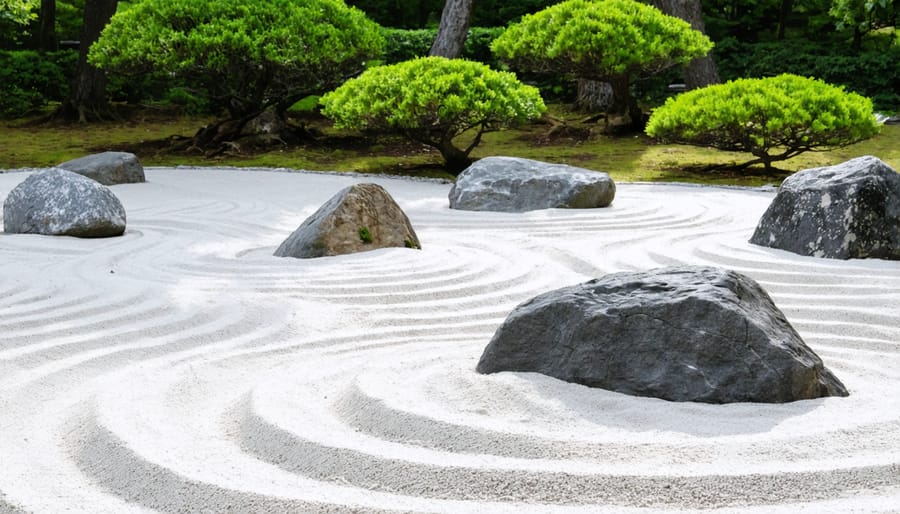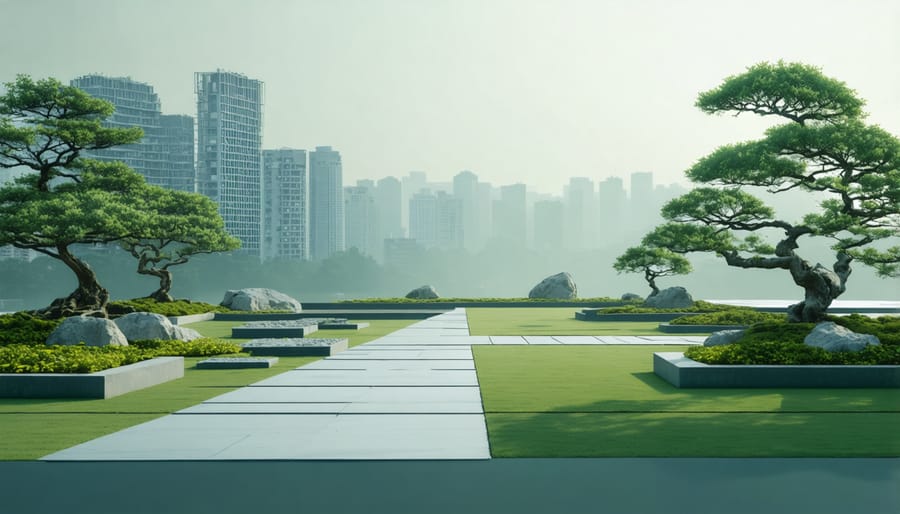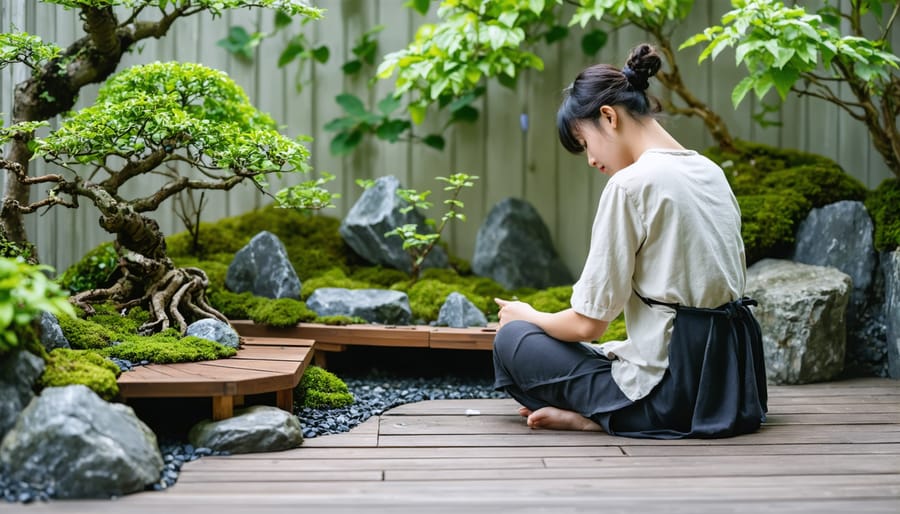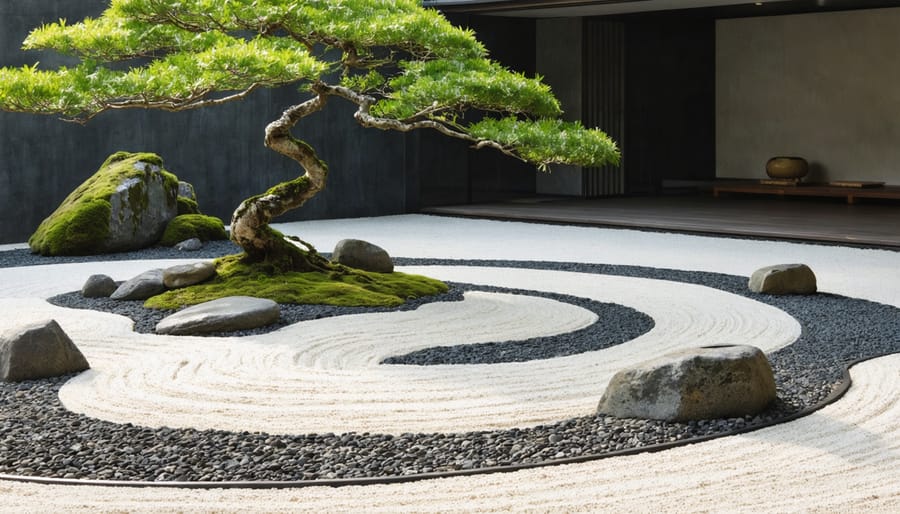Transform your outdoor space into a sacred garden sanctuary by embracing the profound connection between mindful design and natural harmony. In traditional Japanese zen gardens, every rake stroke through gravel and carefully positioned rock speaks to the deeper rhythms of existence. Modern landscaping often fights against nature, imposing rigid structures and high-maintenance demands. Yet zen landscaping teaches us to work with the land’s natural contours, celebrating imperfection and finding beauty in simplicity. This approach isn’t just about aesthetics—it’s a radical departure from resource-intensive conventional gardens, offering a sustainable path forward that honors both environmental stewardship and personal tranquility. Whether you’re tending a sprawling yard or a modest patio, zen landscaping principles can guide you toward creating spaces that nourish both the earth and spirit. The art lies not in controlling nature, but in becoming a thoughtful curator of its inherent wisdom.
The Mindful Path: Zen Principles in Garden Design
Simplicity and Space
In Zen landscaping, less truly becomes more as we embrace the art of simplicity and thoughtful spacing. Think of your garden as a living art gallery, where each element has room to breathe and be appreciated fully.
The power of negative space, or ‘ma’ as it’s known in Japanese design, creates a visual rhythm that allows the eye to rest and the mind to find peace. Instead of filling every corner with plants or decorative elements, consider leaving intentional empty spaces that frame your chosen features. These peaceful voids can be as simple as a rake-patterned gravel bed or an open patch of moss.
When selecting plants, focus on a few carefully chosen specimens rather than cramming in varieties. A single Japanese maple, allowed to grow naturally and highlighted by open space around it, creates more impact than a cluttered collection of different trees. The same principle applies to rock arrangements – three thoughtfully placed stones can tell a more powerful story than a scattered array.
Remember, simplicity doesn’t mean boring. It’s about creating purpose and meaning in your garden through careful curation. Start by removing elements that don’t serve a clear purpose, then arrange what remains with intention. Let each plant, stone, or water feature stand as its own statement, surrounded by space that enhances its natural beauty.

Natural Flow and Balance
Creating harmony in a zen-inspired landscape starts with observing and working with nature rather than against it. The key lies in achieving a delicate balance between different elements while maintaining a sense of spontaneity that feels effortless and natural.
Begin by identifying the natural flow of your space – how water moves across the land, where shadows fall throughout the day, and which areas naturally draw the eye. Work with these existing patterns rather than trying to force unnatural arrangements. For instance, if you notice a natural depression in your yard, consider transforming it into a dry creek bed rather than fighting to level it.
Balance in zen landscaping isn’t about perfect symmetry, but rather about creating visual weight that feels harmonious. Pair larger elements with smaller ones, and contrast rough textures with smooth surfaces. A large boulder might be balanced by a cluster of smaller rocks, while a flowing fountain could be complemented by still, reflective pools.
Natural materials play a crucial role in achieving this harmony. Choose local stones, native plants, and sustainable materials that belong in your climate. These elements will not only look more authentic but will also require less maintenance and resources to thrive.
Remember that negative space – the empty areas between elements – is just as important as the features themselves. These spaces allow the eye to rest and create a sense of peace and tranquility that’s essential to zen design.
Gardens as Peaceful Protest
Breaking from Convention
Zen gardens challenge conventional landscaping norms in refreshing and thought-provoking ways. Unlike traditional Western gardens that emphasize symmetry and abundant blooms, zen gardens embrace minimalism and negative space. These gardens have long served as symbols of resilience and quiet rebellion against the status quo.
Instead of meticulously manicured lawns, zen gardens often feature gravel or sand raked into flowing patterns. This simple yet bold choice eliminates the need for water-hungry grass and chemical fertilizers. Large rocks and carefully placed boulders become focal points, celebrating nature’s raw beauty rather than trying to tame it.
Where traditional gardens might pack spaces with colorful annuals, zen gardens find beauty in restraint. A single Japanese maple or a thoughtfully positioned group of moss patches can create more impact than dozens of flowering plants. This “less is more” approach not only reduces maintenance but also creates peaceful spaces that invite contemplation.
Vertical elements in zen gardens often break from convention too. Rather than rigid hedgerows, they might feature asymmetrical pruned trees or bamboo screens that dance in the wind. Water features diverge from the typical fountain centerpiece, appearing instead as simple stone basins or subtle streams that whisper rather than splash.
These gardens show us that breaking from conventional landscaping isn’t just about being different – it’s about creating meaningful spaces that honor both nature and our need for tranquility in an increasingly busy world.

Creating Sustainable Sanctuaries
Zen gardens inherently embrace sustainability principles, making them perfect sanctuaries for both nature and human wellbeing. These thoughtfully designed spaces work in harmony with the local ecosystem, requiring minimal resources while maximizing environmental benefits.
Traditional zen garden elements naturally support sustainability. Rock arrangements and gravel beds require no watering, while native plants adapted to local conditions thrive with minimal intervention. Many zen gardeners incorporate drought-resistant species and moss varieties that naturally regulate soil moisture and provide year-round ground cover without chemical fertilizers.
Water features in zen gardens often utilize rainwater harvesting systems, creating self-sustaining cycles that reduce dependence on municipal water supplies. Strategic placement of plants and hardscape elements helps manage water flow and prevent erosion, while permeable surfaces allow natural groundwater recharge.
The mindful approach to zen gardening extends to material choices. Locally sourced stones, reclaimed wood for benches and structures, and repurposed materials for pathways all reduce the carbon footprint while adding authentic character to the space. Many gardeners incorporate on-site composting systems, turning garden waste into valuable nutrients that enrich the soil naturally.
Wildlife-friendly elements are seamlessly integrated into zen gardens, with native plants providing food and shelter for local birds, insects, and small animals. These sustainable sanctuaries become micro-ecosystems, supporting biodiversity while creating peaceful retreats for human contemplation.
By embracing these sustainable practices, zen gardens demonstrate how beautiful, low-maintenance landscapes can coexist with environmental stewardship, offering a model for modern gardening that honors both tradition and ecological responsibility.
Practical Elements of Zen Landscaping
Essential Materials and Plants
In creating a zen garden, the thoughtful selection of materials and plants is essential for achieving harmony and tranquility. Traditional elements include carefully chosen rocks, gravel, and sand, each playing a vital role in the garden’s composition. Large, weathered stones serve as focal points, while smaller rocks create natural boundaries and visual interest.
Fine gravel or sand, typically in neutral colors like white or beige, forms the foundation for many zen gardens. This material is carefully raked into patterns that represent water, creating a sense of movement and flow. The meditative act of raking these patterns has become synonymous with zen gardening practice.
Plants in zen gardens are deliberately minimal but meaningful. Consider incorporating moss for its soft, green presence and ability to thrive in shaded areas. Japanese maples offer elegant structure and seasonal color changes, while bamboo provides natural screening and gentle rustling sounds. These can be combined with healing garden elements to create a space that nurtures both body and spirit.
For ground cover, consider slow-growing plants like creeping thyme or dwarf mondo grass, which require minimal maintenance while providing year-round interest. Remember that in zen design, empty space is as important as the elements themselves – resist the urge to overcrowd your garden with too many plants or materials.
Maintenance as Meditation
In the rhythmic motion of pruning, weeding, and tending to your garden, you’ll discover a profound sense of peace that transforms routine maintenance into moving meditation. Each deliberate snip of the pruning shears, every mindful step between plants, becomes an opportunity to connect with the present moment.
Unlike the rushed nature of modern life, garden maintenance invites us to slow down and observe. Notice how the morning light filters through leaves, feel the texture of soil between your fingers, and listen to the subtle rustle of foliage in the breeze. These sensory experiences ground us in the now, creating a natural state of mindfulness.
Many gardeners find that regular tasks like deadheading flowers or removing weeds become their daily meditation practice. The repetitive nature of these activities allows the mind to settle, while the physical connection with living plants provides a sense of purpose and harmony with nature.
To enhance this meditative experience, try approaching each task with intention. Before beginning, take a few deep breaths and set an intention for your garden work. Move slowly and deliberately, paying attention to each action. When thoughts arise, acknowledge them gently and return your focus to the task at hand.
Remember, garden maintenance isn’t just about keeping plants healthy – it’s an opportunity to nurture your own well-being through mindful engagement with nature.

Small Space Solutions
Even with limited space, you can create a serene zen garden that captures the essence of traditional Japanese design. The key is to embrace the principle of “less is more” and focus on simplicity and intention in every element you choose.
Start by decluttering your available space, removing any unnecessary items that might create visual noise. In zen philosophy, empty space (known as “ma”) is just as important as the elements you include. For small patios or balconies, consider using vertical space with bamboo screens or climbing plants to create layers of interest without sacrificing ground area.
Incorporate miniature versions of classic zen elements. A small water feature, like a compact bamboo fountain, can provide the soothing sound of flowing water. Replace large rocks with carefully selected smaller stones, arranging them in asymmetrical groups of three or five. Use fine gravel or sand in containers to create your own version of a traditional zen garden, complete with ripple patterns you can rake with a miniature tool.
For plant selection, choose specimens that maintain their shape and require minimal pruning. Dwarf Japanese maples, compact bamboo varieties, and small ornamental grasses work wonderfully in containers. Consider mounting moss gardens on vertical surfaces or creating tiny bonsai displays to maximize your connection with nature while minimizing space requirements.
Remember that zen gardens are meant to be contemplative spaces. Even in a small area, include a simple seating arrangement – perhaps a single chair or cushion – where you can sit and appreciate your carefully curated space. Use soft, indirect lighting to extend your enjoyment into the evening hours while maintaining the garden’s peaceful atmosphere.
In embracing zen gardening principles, we create more than just aesthetically pleasing spaces – we craft sanctuaries that speak to both our inner peace and our values. These thoughtfully designed landscapes serve as quiet statements against the conventional, resource-intensive lawns that have become synonymous with modern suburbia.
When you rake patterns into gravel, choose native plants over exotic varieties, or create a simple rock arrangement, you’re participating in an ancient tradition that honors simplicity and mindfulness. Yet simultaneously, you’re making a bold contemporary statement about sustainability and responsible land stewardship.
The beauty of zen-inspired landscaping lies in its dual nature: while it provides a peaceful retreat for personal reflection, it also demonstrates how we can live more harmoniously with our environment. Your garden becomes a living example of how less can truly be more, showing visitors and passersby that beauty doesn’t require excessive water use or chemical treatments.
As you tend to your zen garden, remember that each mindful choice – from selecting drought-resistant plants to incorporating reclaimed materials – ripples outward into the community. You’re creating not just a space for meditation and relaxation, but a gentle reminder that there are alternatives to conventional landscaping practices.
Let your garden be both your sanctuary and your statement, a place where personal peace and purposeful resistance grow together in perfect harmony.




